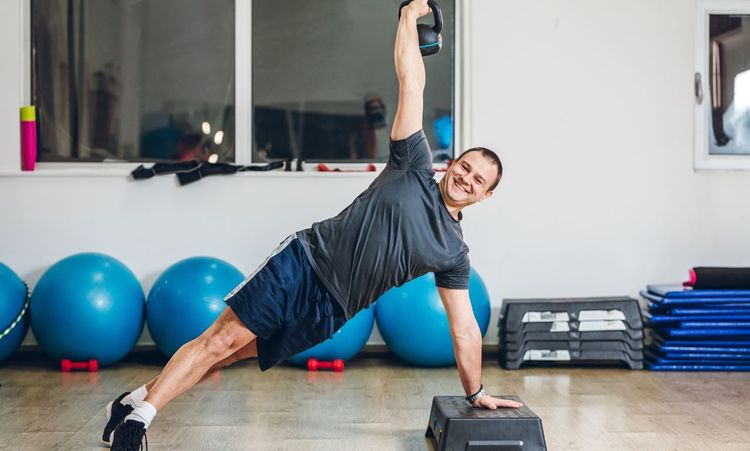Starting a fitness journey feels like stepping into the unknown. You push through that first workout, muscles shaking, wondering when results will show. But fitness happens in stages—some quick, others taking months. The good news? Your body starts changing from the very first exercise session. These changes begin at the cellular level before becoming visible in the mirror. Understanding this timeline helps set realistic expectations and keeps motivation high when progress seems slow.
How long does it take to get fit?
Fitness doesn't arrive overnight. For most people, noticeable improvements take about four to eight weeks of regular training. Your current fitness level plays a huge role in this timeline. Complete beginners often see faster initial changes than experienced gym-goers. Your age, sleep quality, stress levels, and eating habits also affect your progress speed. Genetics matter too, but don't blame your DNA too quickly. Consistency trumps genetics most of the time.
The type of fitness you're chasing matters enormously. Building endurance might happen faster than gaining significant muscle mass. Weight loss results vary widely between individuals. Some people drop pounds quickly while others need more time. The key isn't finding shortcuts but establishing habits that stick for life.
How long does it take to build muscle?
Building noticeable muscle takes patience and proper training. Most people gain about 1-2 pounds of muscle monthly with consistent strength training. Men typically build muscle faster due to higher testosterone levels. Women still gain strength and muscle definition but usually at a slower pace. Your body type also influences your muscle-building potential. Some people pack on muscle easily while others stay naturally lean.
Nutrition plays a crucial role in this process. You need sufficient protein and a slight calorie surplus to build new muscle tissue. Without proper fuel, your body lacks the building blocks for growth. Sleep matters just as much as your gym sessions. During deep sleep, your body releases growth hormone to repair and build muscle.
On the Day of Exercise:
Immediate Energy Systems Activation
Your body kicks into high gear the moment you start moving. Heart rate increases to pump more oxygen-rich blood to working muscles. Blood gets redirected from digestive organs to power your exercise performance. Your breathing quickens to match your body's increased oxygen demands. Stress hormones like adrenaline surge through your system, preparing you for action.
The brain releases endorphins—natural mood-boosting chemicals that create that exercise high. Blood sugar levels stabilize as muscles pull glucose from your bloodstream for fuel. Your body temperature rises as muscles generate heat during contraction. These immediate changes happen whether you've exercised for years or just started today.
Mental Benefits Begin Immediately
Exercise clears mental fog even before you finish your workout. A single session can reduce anxiety levels for several hours afterward. Focus and concentration improve as blood flow to the brain increases during movement. Problem-solving ability gets a temporary boost from improved neural connections. Creativity often flows more easily after moderate physical activity. The stress-reducing effects begin almost immediately during your workout. Tension melts from tight muscles as you move through your exercises. Self-confidence gets a bump from the simple act of showing up for yourself. These mental benefits provide instant gratification while waiting for physical changes.
The Day After Exercise:
Recovery Processes in Action
The morning after a workout, your muscles might announce themselves with soreness. This feeling, called DOMS, peaks around 24-48 hours after exercise. Your body increases blood flow to worked muscles to deliver healing nutrients. Tiny tears in muscle fibers from yesterday's workout begin their repair process. Your metabolism stays slightly elevated as your body works on recovery.
Hunger might increase as your body demands materials for repair and growth. Water retention sometimes occurs as muscles store extra fluid for recovery purposes. Energy levels vary—some people feel energized while others experience temporary fatigue. Your immune system shows subtle changes as it responds to the positive stress of exercise.
Foundation for Progress
Each recovery day builds your fitness foundation brick by brick. The body adapts specifically to the challenges you presented during your workout. Muscle fibers slowly strengthen to prepare for future similar demands. Neural connections between brain and muscles improve, enhancing movement efficiency. Your heart recovers more quickly between exercise bouts, showing early cardiac benefits.
Consistency matters more than intensity during these early stages. Recovery sets the stage for progress—without it, improvement stalls quickly. Each workout creates a stimulus, but the magic happens during rest periods. Your body essentially rebuilds itself slightly stronger after each proper recovery period.
The Week After Exercise:
Initial Adaptations Begin
The first week brings subtle but meaningful changes throughout your body. Your resting heart rate might drop by a beat or two. Sleep quality often improves as your body adjusts to regular physical activity. Energy levels typically become more stable throughout the day. Small improvements in endurance make daily activities feel slightly easier.
Blood volume increases slightly, improving oxygen delivery to working muscles. Mitochondria—your cells' power plants—begin to multiply in active muscle tissues. Your nervous system adapts, making movements more coordinated and efficient. These changes happen beneath the surface before visible transformations appear.
Mindset Shifts Take Root
Psychological changes during week one often outpace physical ones. Exercise becomes less daunting as your body remembers movement patterns. The gym environment feels more familiar and less intimidating. Small successes build confidence in your ability to stick with your program. The habit-forming process begins, making regular exercise feel more natural.
Mood improvements become more consistent with regular workouts. Stress management skills develop as you learn to channel tension through movement. Sleep cycles often regulate, providing better rest and recovery. These mental shifts create the foundation for long-term consistency and success.
Initial Gains (Weeks 1-4):
Neuromuscular Improvements Lead the Way
The first month brings changes that go beyond physical appearance. Strength gains happen quickly as your brain learns to recruit more muscle fibers. Movement patterns become smoother as your nervous system adapts to new exercises. Coordination improves, making complex movements feel more natural and easy. Your balance gets better, reducing the risk of falls and injuries.
Heart efficiency increases, pumping more blood with each beat. Lung capacity expands slightly, making breathing during exercise less labored. Blood pressure might show small improvements even in this early stage. These functional gains create the foundation for more visible changes later.
Early Visible Changes
Some physical changes start becoming noticeable around week four. Muscle tone improves slightly, especially in previously inactive individuals. Water retention patterns might change, affecting how your clothes fit. Some people notice reduced puffiness in the face and extremities. Energy levels typically increase, bringing a more vibrant appearance. Posture often improves as core and back muscles strengthen. Skin might appear more vibrant from increased blood circulation. Sleep improvements can reduce dark circles and eye puffiness. These subtle changes often get noticed by others before you see them yourself.
Noticeable Changes (Months 2-3):
Body Composition Shifts
Real transformation takes hold during months two and three. Fat loss becomes more noticeable as your metabolism adapts to regular activity. Muscle definition emerges, especially in areas you've consistently trained. Clothes fit differently as your body redistributes weight and builds lean tissue. The scale might not change dramatically, but body composition improves. Cardiovascular capacity shows significant gains by this stage. Endurance improves, allowing longer or more intense workout sessions. Recovery between exercise sets happens faster than before. These functional improvements translate into visible changes and better performance.
Beyond the Physical
Life quality improvements become unmistakable during this period. Stress resilience increases substantially with consistent exercise. Mental clarity extends beyond workout times into everyday life. Confidence grows as you accomplish things previously thought impossible. Self-image improves as you witness your body's remarkable adaptability. Energy becomes more consistent throughout the day. Mood stability improves, with fewer dramatic emotional swings. Sleep quality reaches new levels, supporting both physical and mental health. These holistic benefits often become the main motivation for continuing your fitness journey.
How to Safely Speed Up Your Fitness Progress
Step Up Your Workout Intensity & Protein Intake
Gradually increase workout difficulty to keep challenging your body. Add weight, reps, or reduce rest periods as exercises become easier. Incorporate interval training to spike heart rate and accelerate cardiovascular adaptations. Progressive overload remains the most reliable path to continued improvement.
Protein requirements increase with training intensity. Aim for 0.7-1 gram of protein per pound of body weight daily. Spread protein intake throughout the day for optimal muscle synthesis. Quality matters—focus on complete protein sources containing all essential amino acids.
Eat to Fuel Your Body
Food is information that tells your body how to respond to training. Balance macronutrients based on your specific fitness goals. Time meals strategically around workouts for optimal energy and recovery. Stay hydrated—even mild dehydration significantly impairs performance and results.
Don't fear carbohydrates—they fuel high-intensity exercise effectively. Healthy fats support hormone production necessary for recovery and growth. Micronutrients from fruits and vegetables optimize cellular function and repair. Remember that severe calorie restriction ultimately backfires for long-term fitness progress.
Prioritize Strength Training Over Steady Cardio
Resistance training delivers more lasting metabolic benefits than cardio alone. Lifting weights preserves muscle mass during weight loss phases. Strength work improves bone density, joint stability, and functional movement. The metabolic boost from muscle growth continues long after your workout ends.
Compound movements like squats and deadlifts give more bang for your buck. Free weights generally create more muscle activation than machines. Body weight exercises build practical strength for everyday movements. Finding your sweet spot between intensity and recovery prevents plateaus.
Don't Forget Recovery
Progress happens during rest, not during workouts themselves. Schedule dedicated recovery days into your weekly routine. Quality sleep ranks among the most powerful recovery tools available. Active recovery like walking or gentle yoga promotes blood flow without additional stress.
Proper warm-ups and cool-downs reduce injury risk and soreness. Foam rolling and stretching maintain muscle quality and joint mobility. Stress management techniques support your body's repair processes. Listen to your body—pushing through genuine fatigue leads backward, not forward.
Mix Up Your Routine Every 6-12 Weeks
Your body adapts quickly to familiar movement patterns. Planned program changes prevent plateaus and maintain progress. Try new exercises that challenge your muscles from different angles. Periodization—cycling intensity and volume—keeps results coming long-term. Cross-training improves overall fitness while preventing overuse injuries. Different workout styles challenge your body in complementary ways. Exercise variety maintains mental freshness and motivation. These strategic changes keep your fitness journey interesting and productive.
Explore Fitness Apps
Technology makes optimizing your workouts easier than ever before. Tracking apps provide objective feedback on your progress patterns. Virtual coaches offer structured programs tailored to your goals. Community features provide accountability and social support.
Heart rate monitors help dial in your ideal training intensity. Sleep tracking identifies recovery optimization opportunities. Nutrition apps simplify meal planning and portion awareness. Used thoughtfully, technology removes guesswork from your fitness equation.
Join a Workout Community
Social support dramatically increases exercise adherence rates. Group workouts often push you harder than solo sessions. Shared goals create accountability and friendly competition. Learning from others accelerates your progress through collective wisdom.
Scheduled classes make showing up non-negotiable. Training partners notice form issues you might miss yourself. Community celebrations make fitness milestones more meaningful. The social connections formed often become as valuable as the physical benefits.
Conclusion
Your body transforms continuously from your very first workout. Some changes happen instantly, while others require months of consistency. Progress rarely follows a straight line—expect plateaus along with breakthroughs. The most meaningful changes often extend beyond physical appearance into mental and emotional wellbeing.
Remember that fitness isn't a destination but a lifelong journey. Small daily actions compound into remarkable results over time. Focus on progress rather than perfection to maintain motivation. Celebrate improvements in how you feel and function, not just how you look. Your body is remarkably adaptive—trust the process and enjoy watching it change.




